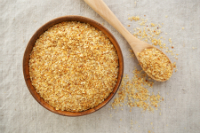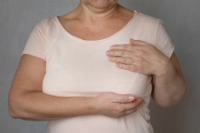October 2019 Edition
What’s New
The state with the highest incidence of breast cancer is Massachusetts. According the United States Centers for Disease Control (CDC), there are 139.5 new cases per 100,000 female residents in the state. Meanwhile, the state with the lowest incidence of breast cancer is Arkansas with 101.9 new cases per 100,000 female residents.
Breast Thermography: An Important Adjunct Test for Detecting Breast Cancer

The moment a woman feels a lump in her breast is likely one of the most frightening moments in her life. What could it be? What if it’s cancer? Every year in the U.S., one in eight women will be diagnosed with breast cancer and more than 40,000 will die from the disease. Early detection is key to surviving breast cancer.
The gold standard for early detection is a mammogram. However, aside from the discomfort of the test, there can be serious inconsistencies in the results: mammography can generate both false-negative results (not detecting cancer that is actually present) and false-positive results (detecting cancer that is not actually present). If a test is false-positive, the result could be overdiagnosis and a woman going through unnecessary treatment. If the test is false-negative, that could result in a woman not receiving treatment for an existing cancer. That’s why an imaging test known as breast thermography has become a valid and important adjunct test (not a replacement test) for detecting breast cancer. A less invasive test, breast thermography is a secondary test authorized by the FDA to be used only as a risk assessment tool in addition to – but not in place of – mammography.
What is Thermography?
Breast thermography (also known as Digital Infrared Imaging-DII) is a 15-minute, pain-free, non-invasive test that shows the structure of your breast while measuring heat emanating from the surface of your body. Changes in skin temperature are the result of increased blood flow. This is important because even early-stage cancers need a blood supply to bring in nutrients to feed the cancer.
Because temperature change shows up as colors brighter than those of healthy cells, thermography can identify precancerous or cancerous cells earlier and with less ambiguous results. Studies indicate that an abnormal thermography test is 10 times more significant as a future risk indicator for breast cancer than having a family history of breast cancer.
When to Test (may vary based on personal and family medical history)
- Age 20: Initial thermogram
- Age 20 – 29: Thermogram every 3 years
- Age 30 and over: Thermogram annually
Is it Right for Me?
Thermography is not suitable for women who have very large or fibrocystic breasts, are using hormone replacement treatment, have had cosmetic breast surgery, or are nursing or pregnant. Consult with your holistic physician to determine if breast thermography is a good option for you.
Food for Thought. . .
“The best preparation for tomorrow is doing your best today.” – H. Jackson Brown, Jr.
Red Cabbage, Green cabbage, Chinese cabbage: Oh, my!

Some folks might be surprised to learn that cabbage is not in the same category as lettuce, despite their similar appearance. Cabbage is cousin to kale and broccoli and is part of the cruciferous vegetable family. Varying in color from pale green to red and purple, cabbage contains many nutrients that offer health benefits such as protecting against cancer, lowering risk for heart disease, and supporting immunity and digestion.
Researchers have identified 20 different flavonoids and 15 different phenols in cabbage, all of which have antioxidant activity in the human body. These plant nutrients protect the cells from damage (e.g., reducing inflammation), and are linked to a decreased risk of chronic illness. Cabbage also contains a sulfur-compound called sulforophane, which has been shown to have cancer preventive properties. A study conducted at the University of Missouri, looked at another chemical found in cabbage, called apigenin. In lab studies, apigenin was found to decrease tumor size when cells from an aggressive form of breast cancer were implanted in mice. More research is required to determine if apigenin has the potential to be used as a non-toxic treatment for cancer in humans. Lastly, red-purple cabbage contains the powerful antioxidant anthocyanin that bolsters protection for red blood cells.
Oh My is right: there are so many kinds of cabbage, with so many ways to protect your health. Be sure to include this cruciferous vegetable in your weekly diet. When buying cabbage, select one that is heavy for its size. The leaves should be tightly wrapped, as loose, limp leaves indicate an older cabbage. Store cabbage in the refrigerator for up to 2 weeks.
Cabbage can be eaten raw, or steamed, boiled, roasted, sautéed, or stuffed for side dishes or entrees. (If you smell a sulfurous odor while cooking, then the cabbage is overcooked.) Add shredded cabbage near the end of cooking to soups or stews or stir-fry dishes; add it to fresh green salads or chop and drizzle with herbs and olive oil.
Parmesan Garlic Cabbage

Turn cabbage-haters into cabbage-lovers with this tasty side dish. The key to transforming what is often perceived as a bland vegetable into a delectable dish is a matter of seasoning selection. You can’t go wrong with parmesan and garlic, that’s for sure! Turn this side dish into a salad by adding fresh cherry or plum tomatoes. Partner it with eggs, a serving of chicken or your favorite vegan entree, for a more filling meal.
Ingredients
- 2 1/2 tbsp olive oil
- 3 garlic cloves minced
- 1 red onion finely sliced
- 7 handfuls shredded green cabbage
- 1/2 – 3/4 cup shredded parmesan
- Salt and pepper
Preparations
- Heat the oil in a large, covered skillet over high heat.
- Add garlic and onion – cook for 2 minutes until onion is translucent.
- Add cabbage and cook until wilted.
- Stir through parmesan, season to taste with salt and pepper. Serve!
Fermented Wheat Germ Extract (Avemar pulvis)

Fermented Wheat Germ Extract (FWGE) is derived from a patented industrial fermentation of wheat germ. It was formulated by a scientist from Hungary, where it is approved as a “medical nutriment” for cancer patients. FWGE contains a number of substances that are believed to have a positive cancer fighting effect. Two of these compounds, both a type of quinone, have shown “cancer fighting” effects in lab and human studies. In addition to halting the growth of cancer cells, some studies have shown the quinones found in FWGE might interfere or halt the migration of certain types of cancer cells.
FWGE has been studied as both a complement used alongside cancer drugs and as a stand alone nutritional supplement. Findings indicate that in both populations of people there was significant improvement. Those who opted for conventional cancer treatment and those who chose a different treatment route both benefited from the addition of FWGE.
While this news holds promise for FWGE as a non-toxic complementary therapy in cancer treatment, more research is needed to determine:
- What are the physiological action(s) by which FGWE works in the human body?
- For whom FGWE is a safe and effective option?
- Which types of cancer FGWE can be used against?
- What are the side effects and risk for interactions with other health conditions, as well as other herbs, supplements, or prescription drugs?
There is currently a discussion happening in the scientific world about whether FWGE should remain classified as a nutritional supplement or be elevated to a cancer drug. More research is needed before this can be determined. FWGE is typically dosed as a powder in water and the dose varies by individual. As with any new therapy, a discussion should be had with your holistic doctor before using FWGE.
The Cancer Fighting Properties of Green Tea

When it comes to tea, the more pure the leaf in your brew, the better the health benefits. Green Tea (Camellia sinensis) leaves, which do not go through an oxidation process, have the richest nutrient profile among all varieties of tea. Research shows that people who drink four or more cups of green tea each day have a lower overall risk of cancer and women who frequently drink green tea have a lower overall risk (or “lower overall incidence”) for breast cancer.
The powerful micronutrients in green tea are called polyphenols. One type of polyphenol is EGCG (epigallocatechin-3-gallate), which shows promise in protecting cells from cancer. Lab tests and animal studies have shown EGCG is able to inhibit an enzyme that is necessary for cancer cell growth. EGCG also has been successful as a complementary approach in cancer treatment. For example, topical EGCG provides relief from radiation-induced dermatitis experienced by women in treatment for breast cancer. (Always consult with your physician before applying any ointment to your skin before or after a radiation treatment). While promising, it’s important to note that scientists are still investigating the precise mechanisms through which polyphenols such as EGCG exert their effects in the body. One such mechanism is that these compounds are powerful antioxidants that gobble up cellular debris known as free radicals. This scavenging action helps protect cells from damage that could, over time, lead to the development of cancer. While green tea, overall is well regarded among health practitioners, scientists are still pursuing clinical trials to determine if green tea consumption, as well as a dietary supplement of EGCG, may play a role in the prevention and treatment of different cancers.
When selecting tea, be aware that the quality of tea and its nutrient content is degraded by processing. To reap the benefits of tea for wellbeing, use pure, loose leaf tea for hot or iced beverages. Choose organic teas whenever possible. Before taking an EGCG supplement, consult with a holistic health physician to ensure the product is pure and contains the appropriate potency for your health concerns.
Breast Self-Exam for a Woman’s “Bosom Buddies”

It’s important for a woman to be familiar with the look and feel of her own breasts. Performing a breast self-exam (BSE) at least once per month is the best way to detect a lump or other abnormality. It is best to do a BSE the same time every month. For women who are menstruating, choose a time in the month after your cycle completes.
A BSE should be done lying down, or in the shower. You want to feel relaxed, not tense, as you are performing the BSE. Follow these steps:
- Use the pads of your fingers. Use the pads (not the tips) of your three middle fingers for the exam.
- Use different pressure levels. Your goal is to feel different depths of the breast by using different levels of pressure to feel all the breast tissue.
- Take your time. Hurrying through the process could cause you to miss something.
- Follow a pattern. Don’t move randomly around the breast. Instead, move your fingers in a path around the breast. Also, check the area beneath the armpits.
- Look at your beautiful bosom. Women should also look at their breasts in the mirror straight on, as well as while bending forward at the waist. Notice if there is any asymmetry.
If you are uncertain about how to proceed, ask your physician for a demonstration. Also, this video will help you learn how to do a BSE correctly when at home.
What You Might Find During a BSE
For women who are menstruating, breast tissue undergoes changes at various points throughout the monthly menstrual cycle. So you may find lumpy areas or changes in your breast that are completely normal. For all women, breasts often feel different in different places. A firm ridge along the bottom of each breast is normal, for instance. The look and feel of your breasts will change as you age. Finally, diet can alter breast tissue, for example, a diet high in red meat can increase the fibrous feel of the breasts.
Contact Your Doctor If You Notice . . .
- A hard lump or knot anywhere in the breast tissue or under the arm
- Changes in the way your breasts look or feel, including thickening or prominent fullness that is different from the surrounding tissue
- Dimples, puckers, bulges or ridges on the skin of your breast
- A recent change in a nipple to become pushed in (inverted) instead of sticking out
- Redness, warmth, swelling or pain
- Itching, scales, sores or rashes
- Bloody nipple discharge
Your doctor may recommend additional tests and procedures to investigate breast changes, including a clinical breast exam, mammogram, thermography, and ultrasound.
Additional Resources
How to Check Breasts for Lumps (video).
Guiding Principles







